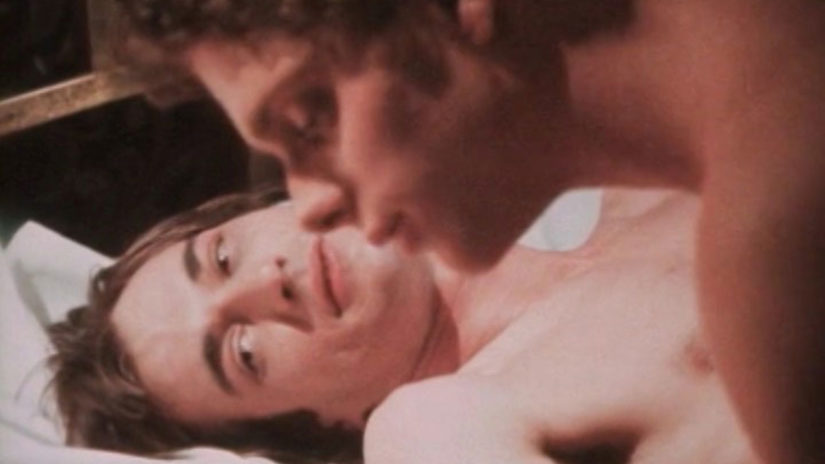For a film intended—on some level—to be erotic, The Destroying Angel (1976) winds up in an extremely grim place. It’s a product of its period, when porn was one of the few routes to speak about queer men’s experiences. Also, the film’s psychedelic quality reflects the “movie as acid trip” sensibility that was already falling out of fashion by the time of its release. But, if you’ve ever wanted to see a gay porn film that feels like it was directed by Nicolas Roeg and Donald Cammell, The Destroying Angel is a must.
To the tune of Pink Floyd’s “Welcome to the Machine,” Caswell Campbell (Tim Kent) rides a motorcycle to a bar. He picks up a man there, but after they leave, he stands on the street and hallucinates the image of himself masturbating in a window high above. His apartment contains two prominent objects: a painting of Edgar Allan Poe and a crucifix. The former nods to The Destroying Angel’s origins in Poe’s short story “William Wilson,” while the latter reflects the fact that Caswell is a seminarian who has decided to take three months off to figure out whether he really wants to commit to priesthood. Chewing an Amanita Muscaria mushroom offered to him by a lover, he participates in several hallucinatory sex scenes. Through the magic of camera tricks, he even has sex with himself.
The Destroying Angel never spells out its themes or lays out Caswell’s life story. But the unpleasantness of the hallucinations he experiences and his groans during sex point to an overwhelming self-hatred. Even at the moment of orgasm, he can’t escape his own consciousness.Throughout the film, Caswell’s malevolent double—a downright demonic manifestation of his sexual repression—emerges to taunt him, as though Caswell transforms into Mr. Hyde when he gets horny.
Director Peter de Rome shoots all of this in a jarring style, with a constant, if clunky, use of zooms and rapid-fire editing loops that bring together images of mushrooms, crosses, and male bodies. The soundtrack is designed to be as unpleasant as the film’s visuals, with a barrage of dissonant electronic buzzes and hums set against the most ominous instrumental sections from several Pink Floyd songs. De Rome wasn’t a polished enough filmmaker to pull off all of the effects he wanted, but the occasional amateurishness of his film adds to the frank depiction of Caswell’s decline.
One of only two De Rome features, The Destroying Angel showcases the talent that attracted the actor John Gielgud to the director’s circle. (The latter, a closeted gay man, saw several of his films in 1971 and wanted to work with De Rome, writing an unproduced script for him to direct as a short and volunteering to record a voice-over for another film.) The use of mushrooms as phallic symbols is more than titillation; De Rome draws on the scholar John M. Allegro’s theories about psychedelics lying at the root of Christianity. Made at a time when it became possible to celebrate the gay libido on-screen, The Destroying Angel was pessimistic about the power of sex and drugs to help overcome queer men’s trauma. It was made after the counterculture had peaked but as gay liberation was in full swing, and it combines ideas influenced by both, especially the transformative functions of psychedelics and sexual desire. Without depicting the homophobia or institutional harm caused by the Catholic church directly, The Destroying Angel spells out its repressive role in Caswell’s life. In the end, the film suggests that the notion of pleasure is as inherently liberating as it is dangerously naïve.
The Destroying Angels screens tonight, August 20, at Anthology Film Archives as part of the series “Best of Narrow Rooms.”



